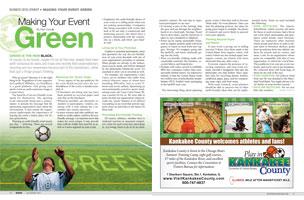
Green is the New Black.
 Of course, to be honest, maybe it's not all that new; people have been earth-conscious for years, but it was only recently that conservationism, recycling and eco-awareness became part of the mainstream, rather than just a fringe group's thinking.
Of course, to be honest, maybe it's not all that new; people have been earth-conscious for years, but it was only recently that conservationism, recycling and eco-awareness became part of the mainstream, rather than just a fringe group's thinking.
Why go green? Because it is the right thing to do. Regardless of your organization's political affiliation, eco-friendliness is a good platform. And giving your sports event an earth-conscious image is a smart move.
The benefits of an eco-friendly event speak for themselves. The sporting event transcends being just a money-maker; it spreads the message that the sponsoring organization cares about the environment. It also means the organization understands the importance of leaving the earth a better place for future generations.
Planning an earth-friendly event means just that - planning. There are several components to this:
Marketing the 'Green' Angle
Every aspect of the pre-publicity for the event should not just stress the eco-friendliness of the event, it should exemplify it:
If brochures are being sent out, have them printed on recycled paper (and note that on the brochure).
Whenever possible, use electronic reminders to participants, vendors, etc. (along with a note stating the e-reminders save money and trees)
In press releases and other publicity materials to media outlets, reinforce the eco-friendly message. Let reporters know this makes the event unique; it may provide them with the fodder they need for an article or a news segment on your event.
Emphasize the earth-friendly theme of your event as a selling point when you are seeking sponsorships. Companies like being associated with events that look to be not only a commercial and marketing success, but which have a positive relationship with the community as a whole, and which 'give back' as well.
Living Up to Your Promises
Explain to potential participants, press and spectators the way the eco-friendliness of your event dovetails with any of your organization's priorities or mission. Many people are already in the reduce-reuse-recycle mode, and will be intrigued by the philosophy behind the event. It's essential to show you're invested as well.
 For example, our organization, Casey Cares, serves children who suffer from critical illnesses, many of whom have breathing difficulties such as cystic fibrosis and severe asthma. Sponsoring an environmentally-sensitive sports fund-raising event, our Casey Cares Green 5K, was a perfect fit for us. We were able to point out that our organization (which already has 'green' features in its offices) was putting on an event that actively supports clean air and looks to the future for these kids.
For example, our organization, Casey Cares, serves children who suffer from critical illnesses, many of whom have breathing difficulties such as cystic fibrosis and severe asthma. Sponsoring an environmentally-sensitive sports fund-raising event, our Casey Cares Green 5K, was a perfect fit for us. We were able to point out that our organization (which already has 'green' features in its offices) was putting on an event that actively supports clean air and looks to the future for these kids.
Promoting Eco-friendly Training
Of course, athletes, whether they're weekend warriors or seasoned competitors, train for each event they participate in. Encourage them to do so in an earth-sensitive manner. We sent tips to registered participants in our race
If running is part of the training, skip the gym and run through the neighborhood or in a local park. Savings: Fossil fuel to drive there, and the electricity it takes to run a treadmill or elliptical.
Power up by eating sustainable foods, such as organic granola made with local grains, or snack on local fruits and veggies. Savings: No wrappers going into the landfills, and fewer chemicals going into the body.
Wear eco-friendly clothing made with sustainable materials like bamboo, recycled fabrics, and biopolymer.
Hydrate with water carried in refillable BPA-free containers (rather than commercially bottled water). An impressive statistic is that the United States sends two million tons of polyethylene terephthalate (PET) bottled water packaging to the landfill each year.
The interesting thing about planning green events is that they tend to become 'think tanks' for event planners. Once you start the planning process, the ideas for going green begin to multiply. Do plenty of research and you're likely to uncover even more options.
Thinking Beyond Paper and Plastic
If your event is giving out or selling souvenir T-shirts, have them made in the United States from organic cotton. (All cotton T-shirts are not created equal; non-organic cottons are treated with more chemicals than any other crop).
Everyone expects the presence of recycling containers, and your event certainly shouldn't disappoint. But take the philosophy one step further. Have separate bins for recycling plastic bottles, cardboard, paper, glass, and for composting water cups, and food waste.
With some research, event planners should be able to uncover lots of other earth-friendly ideas that can be implemented onsite. Some we used included the following:
Shoe recycling: The charity, Soles4Souls, which recycles old shoes for those in need overseas, had a bin at our event where participants and spectators could donate used footwear. (There are numerous other charities which accept used shoes in order to donate them to homeless shelters, grind them up and turn them into athletic surfaces for schools and rec centers, and more. Look for an organization whose goals are compatible with that of your organization, or which has a local base. Then publicize it in your pre-event materials, and you're sure to get donations). We collected three full trash bags of shoes by the end of the race.
Food donation: All leftover food from our 5K was donated to the Maryland Food Bank. You might choose a local shelter or soup kitchen instead.
Race bib recycling: All our race bibs (the numbers worn by runners and walkers) were collected and sent back to Owens-Corning for recycling after the event was over.
Clothing donation: There was a lost and found box at registration and all unclaimed clothing was donated to Goodwill after the event.
Reduced paper waste: All our advertising was done on-line or through existing publications. Rather than using excess print materials, registration for our 5K was available through a local running website, and event results were posted online. All event signage was biodegradable and/or made of post-consumer content recycled materials marked with environmentally friendly inks. We also had signs we could re-use from year to year.
Forget fossil fuel: Special parking spaces were available for TDI/Clean Diesel, hybrid and plug in/electric vehicles. At registration, runners were provided information about how to purchase carbon credits from www.carbonfund.org to offset the carbon emissions from their travel to the event. (You might also encourage people to commute by bicycle, and provide special bike racks or a 'bike valet').
Winning ideas: All winners of their categories received awards made from 100% post-consumer content recycled material.
Certifiable: Ecco Verde, Inc., a local environmental management and training company, certified the race as green. To qualify for this, we had to submit a list of actions we were taking (all of which have been mentioned above) and the goals we expected to achieve by doing so.
Going green means staying in the black It's no secret that athletes have multiple options when it comes to sports events being held. As a planner, you want your event to stand out. We were planning a 5K which was especially tough, since multiple races are held in our area (not to mention everywhere else) each day of each weekend. We played up the eco aspect of our event, and hoped for the best.
It's no secret that athletes have multiple options when it comes to sports events being held. As a planner, you want your event to stand out. We were planning a 5K which was especially tough, since multiple races are held in our area (not to mention everywhere else) each day of each weekend. We played up the eco aspect of our event, and hoped for the best.
The results were better than we'd even hoped. We had expected about 250 runners for our first event in 2010, but close to 500 runners and walkers participated in the Casey Cares Green 5K, Family Fun Walk and 100-yard dash Jammie Jog. (The family-friendly format was also helpful, since people could bring their kids and not have to hire a sitter). We're hoping to exceed that figure for this year's event, which will be held on November 13.
Once your event is over, ask participants for their feedback, and seek out their tips for other ways to make the event earth-friendly.
Sometimes, the carbon footprint is a sneaker mark, and your athletes are ready to help reduce it.

